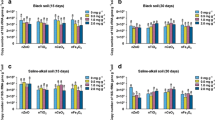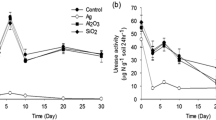Abstract
Purpose
Iron oxide magnetic nanoparticles (IOMNPs) have numerous exciting applications due to their unique chemical and physical properties. With increased applications of engineered nanostructures, releases of such materials to soil are undoubtedly inevitable. Their potential environmental risks have attracted increasing concern. One area of concern is their effect on microorganisms, which are important components of ecosystems.
Materials and methods
In this work, the effect of IOMNPs (Fe3O4 and γ-Fe2O3) on the soil bacterial community has been studied with molecular approaches and enzyme analyses. The community structure and population size were analysed using molecular-based methods, including PCR-denaturing gradient gel electrophoresis and real-time quantitative PCR based on the universal bacterial biomarker, the 16S rRNA gene sequence fragment for the bacterial variable V3 region. In addition, plate counting was conducted to validate the results of molecular methods. Four enzyme activities (dehydrogenase, urease, invertase and phosphatase) involved in cycling the main biologically important nutrients (C, N and P) were measured.
Results and discussion
Our analysis revealed that the addition of IOMNPs could potentially stimulate some bacterial growth and change the soil bacterial community structure, although bacterial abundance does not change. Based on molecular fingerprinting and sequencing analysis, several potential IOMNPs-stimulated bacteria were related to Actinobacteria, such as Duganella, Streptomycetaceae or Nocardioides. Meanwhile, soil urease and invertase activities significantly increased under IOMNPs amendment, which could be a consequence of the changes in the bacterial community.
Conclusions
Molecular evidence suggests that IOMNP addition may facilitate C and N cycling in soil by influencing soil bacterial community. These findings are of great help towards building a comprehensive understanding of the potential impact of nanoparticles on the environment.






Similar content being viewed by others
References
Auffan M, Achouak W, Rose J, Roncato MA, Chaneac C, Waite DT, Masion A, Woicik JC, Wiesner MR, Bottero JY (2008) Relation between the redox state of iron-based nanoparticles and their cytotoxicity toward Escherichia coli. Environ Sci Technol 42:6730–6735
Bahn AN, Dirks OB, Destoppelaar JD, Huisintveld JHJ, Boom A, Hayashi JA (1979) Function of neuraminidases from oral Streptococci and Actinomycetes in the plaque-formation. Caries Res 13:86–87
Colvin VL (2003) The potential environmental impact of engineered nanomaterials. Nat Biotechnol 21:1166–1171
Dick WA, Cheng L, Wang P (2000) Soil acid and alkaline phosphatase activity as pH adjustment indicators. Soil Biol Biochem 32:1915–1919
Feng YZ, Lin XG, Wang YM, Zhang J, Mao TT, Yin R, Zhu JG (2009) Free-air CO2 enrichment (FACE) enhances the biodiversity of purple phototrophic bacteria in flooded paddy soil. Plant Soil 324:317–328
Franco-Correa M, Quintana A, Duque C, Suarez C, Rodriguez MX, Barea JM (2010) Evaluation of actinomycete strains for key traits related with plant growth promotion and mycorrhiza helping activities. Appl Soil Ecol 45:209–217
Ge Y, Schimel JP, Holden PA (2011) Evidence for negative effects of TiO2 and ZnO nanoparticles on soil bacterial communities. Environ Sci Technol 45:1659–1664
Hantke K (2001) Iron and metal regulation in bacteria. Curr Opin Microbiol 4:172–177
He F, Zhao D, Liu J, Roberts CB (2006) Stabilization of Fe-Pd nanoparticles with sodium carboxymethyl cellulose for enhanced transport and dechlorination of trichloroethylene in soil and groundwater. Ind Eng Chem Res 46:29–34
Hu WB, Peng C, Luo WJ, Lv M, Li XM, Li D, Huang Q, Fan CH (2010) Graphene-based antibacterial paper. Acs Nano 4:4317–4323
Illes E, Tombacz E (2006) The effect of humic acid adsorption on pH-dependent surface charging and aggregation of magnetite nanoparticles. J Colloid Interf Sci 295:115–123
Janvier C, Villeneuve F, Alabouvette C, Edel-Hermann V, Mateille T, Steinberg C (2007) Soil health through soil disease suppression: Which strategy from descriptors to indicators? Soil Biol Biochem 39:1–23
Jia ZJ, Conrad R (2009) Bacteria rather than Archaea dominate microbial ammonia oxidation in an agricultural soil. Environ Microbiol 11:1658–1671
Ju-Nam Y, Lead JR (2008) Manufactured nanoparticles: An overview of their chemistry, interactions and potential environmental implications. Sci Total Environ 400:396–414
Kanerva T, Palojarvi A, Ramo K, Manninen S (2008) Changes in soil microbial community structure under elevated tropospheric O3 and CO2. Soil Biol Biochem 40:2502–2510
Kang S, Pinault M, Pfefferle LD, Elimelech M (2007) Single-walled carbon nanotubes exhibit strong antimicrobial activity. Langmuir 23:8670–8673
Kasemets K, Ivask A, Dubourguier HC, Kahru A (2009) Toxicity of nanoparticles of ZnO, CuO and TiO2 to yeast Saccharomyces cerevisiae. Toxicol in Vitro 23:1116–1122
Kaye JP, McCulley RL, Burke IC (2005) Carbon fluxes, nitrogen cycling, and soil microbial communities in adjacent urban, native and agricultural ecosystems. Glob Change Biol 11:575–587
Kennedy AC, Gewin VL (1997) Soil microbial diversity: Present and future considerations. Soil Sci 162:607–617
Kirk JL, Beaudette LA, Hart M, Moutoglis P, Khironomos JN, Lee H, Trevors JT (2004) Methods of studying soil microbial diversity. J Microbiol Meth 58:169–188
Klaine SJ, Alvarez PJJ, Batley GE, Fernandes TF, Handy RD, Lyon DY, Mahendra S, McLaughlin MJ, Lead JR (2008) Nanomaterials in the environment: Behavior, fate, bioavailability, and effects. Environ Toxicol Chem 27:1825–1851
Kumar N, Shah V, Walker VK (2011) Perturbation of an arctic soil microbial community by metal nanoparticles. J Hazard Mater 190(1–3):816–822
Lee J, Mahendra S, Alvarez PJJ (2010) Nanomaterials in the construction industry: a review of their applications and environmental health and safety considerations. Acs Nano 4:3580–3590
Liu JF, Zhao ZS, Jiang GB (2008) Coating Fe3O4 magnetic nanoparticles with humic acid for high efficient removal of heavy metals in water. Environ Sci Technol 42:6949–6954
Liu SB, Wei L, Hao L, Fang N, Chang MW, Xu R, Yang YH, Chen Y (2009) Sharper and faster "nano darts" kill more bacteria: a study of antibacterial activity of individually dispersed pristine single-walled carbon nanotube. Acs Nano 3:3891–3902
Meng H, Xia T, George S, Nel AE (2009) A predictive toxicological paradigm for the safety assessment of nanomaterials. Acs Nano 3:1620–1627
Muyzer G, Dewaal EC, Uitterlinden AG (1993) Profiling of complex microbial populations by denaturing gradient gel electrophoresis analysis of polymerase chain reaction-amplified genes coding for 16S rRNA. Appl Environ Microbiol 59:695–700
Nowack B (2009) The behavior and effects of nanoparticles in the environment. Environ Pollut 157:1063–1064
O’Donnell AG, Seasman M, Macrae A, Waite I, Davies JT (2001) Plants and fertilisers as drivers of change in microbial community structure and function in soils. Plant Soil 232:135–145
Perez JM, O’Loughin T, Simeone FJ, Weissleder R, Josephson L (2002) DNA-based magnetic nanoparticle assembly acts as a magnetic relaxation nanoswitch allowing screening of DNA-cleaving agents. J Am Che Soc 124:2856–2857
Sadowsky MJ, Schortemeyer M (1997) Soil microbial responses to increased concentrations of atmospheric CO2. Glob Change Biol 3:217–224
Schinner F, Vonmersi W (1990) Xylanase-activity, Cm-cellulase-activity and invertase activity in soil - an improved method. Soil Biol Biochem 22:511–515
Sjogren CE, Johansson C, Naevestad A, Sontum PC, BrileySaebo K, Fahlvik AK (1997) Crystal size and properties of superparamagnetic iron oxide (SPIO) particles. Magn Reson Imaging 15:55–67
Sondi I, Salopek-Sondi B (2004) Silver nanoparticles as antimicrobial agent: a case study on E-coli as a model for Gram-negative bacteria. J Colloid Interf Sci 275:177–182
Tabatabai MA (1994) Soil enzymes. Methods of Soil Analysis. Soil Society of America, Madison
Tamura K, Dudley J, Nei M, Kumar S (2007) MEGA4: Molecular evolutionary genetics analysis (MEGA) software version 4.0. Mol Biol Evol 24:1596–1599
Tong ZH, Bischoff M, Nies L, Applegate B, Turco RF (2007) Impact of fullerene (C-60) on a soil microbial community. Environ Sci Technol 41:2985–2991
Waychunas GA, Kim CS, Banfield JF (2005) Nanoparticulate iron oxide minerals in soils and sediments: unique properties and contaminant scavenging mechanisms. J Nano Res 7:409–433
Acknowledgements
This work was financially supported by National Natural Science Foundation of China (Project: 41001142, 60501009) and China-US International Science and Technology Cooperation Program (2009DFA31990).
Author information
Authors and Affiliations
Corresponding author
Additional information
Responsible editor: John W. G. Cairney
The first two authors have the equivalent contributions to the manuscript.
Electronic supplementary material
Below is the link to the electronic supplementary material.
ESM 1
(DOC 1385 kb)
Rights and permissions
About this article
Cite this article
He, S., Feng, Y., Ren, H. et al. The impact of iron oxide magnetic nanoparticles on the soil bacterial community. J Soils Sediments 11, 1408–1417 (2011). https://doi.org/10.1007/s11368-011-0415-7
Received:
Accepted:
Published:
Issue Date:
DOI: https://doi.org/10.1007/s11368-011-0415-7




